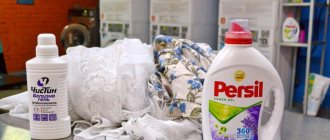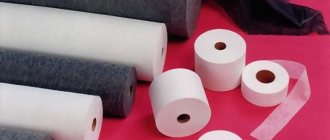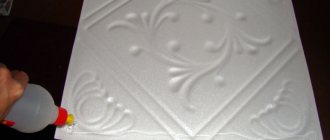Kitchen flooring is selected especially carefully, because it should not only be beautiful and aesthetically pleasing, but also durable and practical in everyday life. Linoleum for the kitchen not only meets the listed characteristics, but also has additional qualities that make it an excellent solution for the most used room in the apartment. We will tell you in this article how to choose the right linoleum, what types exist, and what to pay attention to when laying it.
Types and resistance class
There are several types of waterproof linoleum for the kitchen, which differ in composition and manufacturing technology. Its purpose and resistance class depend on its technical characteristics.
By appointment it happens:
- Household – for residential buildings;
- Commercial and semi-commercial – for public institutions;
- Industrial – for industrial premises.
The resistance class is determined by the degree of load that the floor covering can withstand. Today there are 4 degrees of resistance:
- Short;
- Average;
- High;
- Maximum wear resistance.
Expert advice
Ksenia Lavrova
Ksenia – flooring sales consultant
The resistance class correlates with the purpose: low is intended for residential premises, medium – for offices, high – for industrial facilities.
Products are marked with numbers from 21 to 43. Accordingly, the higher the number, the more durable and wear-resistant the product is.
The best option for the kitchen would be linoleum with resistance class 21-33.
In this case, it is best to choose a coating of at least 23 wear resistance class, designed for high-intensity, regular use. The most durable linoleum for the kitchen will be semi-commercial varieties (class 31-33), which are designed for maximum everyday load.
Manufacturers of linoleum for the kitchen: ratings and reviews
Companies such as TARKETT, ARMSTRONG-DLW, FORBO, GERFLOR, JUTEKS, Upofloor, SOMMER, GRABOFLOOR have long and well established themselves in the domestic market of linoleum manufacturers. When choosing a manufacturer, you should be guided not only by company websites, but also by consumer reviews.
The most popular according to these criteria is Tarkett linoleum. The photos clearly demonstrate the variety of its models, which are used in the most stylish and sophisticated interiors. The company produces linoleum under two brands – “Tarkett” and “Sinteros”. Customer reviews note the density and wear resistance of this flooring. To be fair, it is worth noting that Tarkett is a quality manufacturer, but far from the only one of his kind.
One of the first advantages of Tarkett linoleum is its ease of installation; in addition, it is reliable and belongs to the category of warm coating
When deciding which linoleum to choose for the kitchen, you should take into account the different features of the coating and its advantages. At the same time, you should not save, since it is in the kitchen that linoleum is subjected to heavy loads and contamination. Choosing the right model, color and texture is now not a problem thanks to the widest range of linoleum, which is rightfully considered the most popular floor covering.
Choice of colors
The most popular colors are imitation wood, stone, marble, parquet, boards, laminate. But options with patterns and ornaments can also be considered, especially in interior design in vintage and retro style.
The choice of color scheme depends on the area of the room, its design and decoration. For example, the floor can match the color of the baseboards or door frames and window frames, but this is not essential.
Designer tips
Elena Vasilyeva
Elena is an interior designer, founded her own design school in 2014
It is not recommended to match the floor tone to furniture or curtains, as this will lead to color redundancy and disharmony. But the overall color palette of the room should be taken into account so that the floor does not stand out from the decor.
If the room is decorated in warm colors, choose light linoleum for the kitchen in warm colors, which not only add coziness to the room, but also go well with the interior in a country or classic style.
Minimalism, hi-tech and other ultra-modern styles are characterized by a cool color scheme. If you have a gray, black or white kitchen, dark linoleum for the kitchen in gray, light blue or blue tones will look good.
Designer tips
Elena Vasilyeva
Elena is an interior designer, founded her own design school in 2014
When choosing a design, consider not only the style, but also the size of the room. A motley floor will make a small room visually smaller, so it’s better to go with a plain option or a calm wood-like color.
In a large or kitchen-living room, you can afford linoleum under tiles with colorful designs, designs or patterns. But at the same time, the decoration and furniture should be monochromatic.
How to choose a manufacturer?
In today's construction market, the most famous and worthy manufacturer of linoleum is the Russian Tarkett, which produces products under the Polystyl, Tarkett and Sinteros brands. This company has several collections of different types of linoleums; household ones can be purchased on average from 250 to 700 rubles per square meter, semi-commercial - from 300 and above.
Of the foreign brands, the Belgian iDEAL and IVC, and the Slovenian Juteks have proven themselves best. The price ratio is approximately the same.
Choosing linoleum for the kitchen is a very responsible matter, because you need to take into account many parameters. Of course, the main role is played by the budget of your renovation and the design of the future kitchen, and in order for the floor of your kitchen to remain in its original form for a long time, it is better to choose semi-commercial, heterogeneous linoleum, with a wear resistance rating of at least 31, and, if possible, natural.
Dimensions
Linoleum is usually sold in rolls, with coating thickness varying from 0.7 mm to 4.5 mm and width from 2 to 5 m.
For the kitchen, the optimal thickness is 1.5–3 mm. Wear resistance does not depend on the size of the substrate, but only on the thickness and material of the top layer.
The width of the rolls is chosen depending on the size of the room. In small kitchens, for example, it is advisable to lay the material “in one piece”.
It is important to remember about transportation. If you decide to install a covering in the kitchen without joints, then it is not a fact that a dimensional roll of 4-5 m wide will be able to be delivered to a high-rise apartment without any problems.
Which class to choose for the kitchen?
- For residential premises, a product of classes 21-23 is recommended. It is not intended for heavy loads, but will perform well at home. The thickness of the protective coating on it ranges from 0.3 to 0.5 mm.
- If the premises are actively used, then it is worth buying a higher class, preferably 30-32 classes. Having a micro-relief textured - non-slip and non-hygroscopic surface. The thickness of the protective coating must be at least 0.3 mm.
- When purchasing, it is better to pay attention to models with a microstructure. This surface is non-slip and at the same time dirt does not accumulate in the micropores.
Design solutions
A pattern that imitates boards, parquet or laminate is ideal for the kitchen. Monochrome solutions in light colors look no less stylish. This option is ideal for Scandinavian style or minimalism.
Wood-look linoleum will make the decor more noble; it will fit perfectly into a classic interior with solid wood furniture.
Stone and marble finishes are organic in bright interiors in a modern or neoclassical style.
Light monochromatic options are suitable for small rooms, and bright ones are suitable for fashionable design in fusion, retro or vintage style.
Floor preparation
Linoleum can be laid on any flat base, including OSB boards, boards, concrete screed or old flooring, such as laminate or parquet. The key point is to level the floor for installation. The smoother the base, the more beautiful the future floor will look and the longer the finish will last.
Expert advice
Ksenia Lavrova
Ksenia – flooring sales consultant
If there are defects on the concrete screed, it is best to eliminate them by rubbing. Any bulges or depressions will be felt under the thin surface, which will cause inconvenience in everyday use. It is recommended to pour a self-leveling floor under the ultra-thin coating to make the surface perfectly flat. The joints between boards or sheet materials should be puttied to minimize the slightest defects on the surface of the future floor.
Laying linoleum
Before laying, the floor must be leveled and cleared of construction debris and dust, and allowed to dry from putty and moisture. Then you should choose one of the installation options :
- Screed with skirting boards;
- Gluing with double-sided tape;
- Using glue.
The first option is suitable for small spaces where installation in one piece is possible. In large rooms, the reliability of such fastenings will be quite low.
The next two options provide a tighter fit, which means durability, smoothness and strength of the coating.
So, let's look at how to put linoleum in the kitchen using tape or glue:
- Leave the new rolls indoors for a day.
- Roll out the rolls and join them, trim off the excess parts near the walls and corners.
- Roll the covering to the middle of the room and apply tape or glue to the exposed part of the floor.
- Gently roll the rolls over the adhesive surface, smoothing them out to prevent wrinkles and bubbles.
- Fold down the non-glued side and apply glue or tape to the subfloor to then glue down the rest of the roll.
After the glue has dried, skirting boards are installed around the perimeter, which make the floor more aesthetically pleasing and the design complete.
Caring for linoleum in the kitchen: choosing products and materials
One of the main advantages of using linoleum in the kitchen is its ease of maintenance. The housewife does not have to think about how to clean the linoleum in the kitchen, since classic detergents are suitable. At the same time, given that kitchen surfaces get clogged faster, floor care should be systematic and regular.
A protective layer, which, as a rule, is laid by the manufacturers themselves, helps protect linoleum from excessive contamination. Special protection can be applied to the floor once or twice a year. This measure significantly extends the life of the material and helps repel grease and dirt.
Helpful advice! To clean, you can use a solution of regular baking soda and detergent. The ingredients are mixed in proportions 1:1 (a tablespoon of each), poured with water. Next, use a brush to clean the surface. To clean the floor and make the surface shine, use a vinegar solution.
Linoleum is easy to care for, the kitchen with it is easy to clean even from difficult stains
It is enough to carry out such a simple procedure once a month, taking into account the fact that the floors are washed in the usual way as they become dirty, but at least once a week. Proper care of linoleum flooring will significantly extend its service life.
Linoleum under the “warm floor” system
The heat resistance of a material directly depends on the raw materials from which it is made. There are 4 main types of coatings for residential buildings:
- PVC (vinyl) - with a synthetic top layer that is resistant to water, coloring chemicals and heat, which allows it to be laid on a “warm floor” system. But vinyl can only be heated to 29-30 degrees. At higher temperatures it begins to deform.
- Alkyd - made from fabric-based resin. It has a high degree of heat and sound insulation, but requires careful handling during installation and operation due to its increased fragility. When heated, it deforms.
- Nitrocellulose is an option for perfectly smooth floors, as it has no lining and is not suitable for apartments or houses where floor insulation is required. The material is highly flammable and therefore not suitable for kitchens or under heated floors.
- Natural – made from cork, resin, lime and vegetable oils. The key advantages are environmental friendliness, fire resistance, and antistatic properties. The coating can only be heated up to 27 degrees, after which it begins to lose its shape.
Expert advice
Ksenia Lavrova
Ksenia – flooring sales consultant
Natural linoleum is ideal for heated floors, as it does not emit toxic substances when heated, does not ignite and tolerates temperature changes well.
If you're on a budget, you can use vinyl on a thin backing. But remember that it can release toxins and smell bad when heated.
Care Tips
Linoleum for the kitchen is a practical, aesthetic and unpretentious coating that is easy to care for, which is why reviews about it are mostly positive.
It is enough to follow simple care tips to maximize the service life and preserve the appearance of the floor covering for many years.
To make linoleum last a long time:
- use furniture with wide wooden legs that do not leave dents on the surface;
- do not drag furniture or other heavy objects to avoid leaving streaks and scratches;
- remove dirt promptly, as vinyl quickly absorbs stains;
- do not use bleaches or abrasives when cleaning;
- If there are open seams on the covering, make sure that no water gets inside, otherwise mold will appear.
Natural material should be treated exclusively with soapy water. Vinyl surfaces can be cleaned with household chemicals and various polishes can be used for shine.











